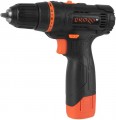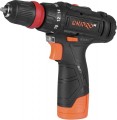Rotation speed
The speed of rotation of the working nozzle provided by the tool.
If a single number is indicated in this paragraph (for example, 1800), it can be either a standard, constant, or maximum rotation speed. This refers to the maximum speed if the tool has more than one speed (see "Number of speeds") and/or a speed controller (see "Functions"). In turn, two or three numbers through an oblique line (for example, 1100/2300/3400) are indicated only for models that have the corresponding number of individual speeds. Each of these numbers indicates the standard (and in the presence of a speed controller — the maximum) number of revolutions at one of the speeds.
Anyway, when choosing a tool by the number of revolutions, it is worth considering both its general type (see "Device") and the specifics of the intended work. Detailed recommendations on this matter are quite extensive, it makes no sense to give them in full here — it is better to turn to special sources. We note only a few general points. So,
high -speed drills nowadays are considered to be drills capable of delivering more than 3000 rpm. In general, high speed contributes to productivity, but there is also a downside: increasing the speed (for the same power) reduces torque — accordingly, the efficiency of working with stubborn materials and large diameter nozzles decreases. Therefore, it makes sense to specifically look for a "high-speed" tool only if speed is of key impor
...tance; it doesn’t hurt to make sure that the model you choose can provide the required efficiency and torque.Torque
Torque is the maximum force with which this model is capable of turning the working nozzle.
Higher torque gives more options, it allows you to cope with complex tasks such as drilling in hard materials, unscrewing stuck screws and nuts, etc. On the other hand, a lot of force requires corresponding power — and this, in turn, affects the dimensions , weight and cost of the tool itself, and also puts forward increased power requirements (mains power, battery capacity or pressure / compressor performance). And for some tasks, excessive torque is basically unacceptable, so for maximum versatility, it is desirable to have
torque control — and this affects the cost even more. And the more steps, the more optimally you can configure the tool to perform a particular type of work. So the general rule is this: when choosing, it is worth considering the specifics of the planned work, and not chasing the greatest working effort.
Detailed recommendations on choosing the optimal torque for different types of tools (see "Device") can be found in special sources. Here we note that it is of key importance primarily for screwdrivers, although it is also given for other types of tools. At the same time, in the “weakest” models, the maximum working force does not exceed 15 Nm, in the most powerful ones it is more than 150 Nm.
Weight
The total weight of the tool is usually the device itself, without attachments. For battery models (see "Power Source"), usually, the weight is indicated with a standard battery installed; for battery-powered models, the weight can be given both with and without batteries, but in this case this point is not particularly important.
Other things being equal, less weight simplifies work, increases accuracy of movement and allows you to use the tool for longer without tiring. However, note that high power and productivity inevitably increase the mass of the tool; and various tricks to reduce weight increase the price and can reduce reliability. In addition, in some cases, a massive design is more preferable. First of all, this applies to work with a large load — for example, drilling holes of large diameter, or making recesses with impact: a heavy tool is more stable, it is less prone to jerks and shifts due to uneven material, vibration of mechanisms, etc.
It is also worth noting that specific weight values are directly related to the type of tool (see "Device"). Screwdrivers are the lightest — in most of them this figure
does not exceed 500 g. Screwdrivers and drill drivers are more "heavy": their average weight is
1.1 – 1.5 kg, although there are many lighter (
0.6 – 1 kg) and heavier (
1.6 – 2 kg or more ) models. And clas
...sic drills and wrenches have the greatest weight: such a tool must be quite powerful, so for them 1.6 – 2 kg is an average, 2.1 – 2.5 kg is above average, and many units weigh more than 2, 5 kg.Chuck type
Two points depend on the type of cartridge: the types of working tools (drills, screwdrivers, etc.) with which this or that model is compatible, and the method of installing / removing them.
—
Key. As the name implies, you will need a special key to work with such a cartridge. The mount itself is usually designed for tools with round shanks (mostly drills) and includes three cams that, when clamped, converge towards the centre, clamping the tool installed in the chuck on the axis of rotation. The main disadvantage of this type of cartridge is the need to use a key: it can be lost and the mount becomes useless. In addition, installing and removing a working tool can be quite a long process. However, the keyed chuck is considered somewhat more reliable than the keyless chuck and more suitable for heavy work.
—
Quick release. Similar to the keyed chuck described above, this type of chuck is designed primarily for drills with round shanks. Its main difference is the absence of a key — you can fix or remove the drill with the help of a hand, without any additional tools. Such chucks are slightly less suitable for work with high loads (for example, in hard materials and/or with large diameter drills), but otherwise they do not lose in any way with the key, and in terms of ease of use they are significantly superior.
—
Under the beat. Bits are working tool
...s used in screwdrivers and screwdrivers (see "Device"). The working side of the bit can have a flat, cruciform or other shape (star, trihedron, etc.), but the shank with which it is fixed in the cartridge is standardly made hexagonal. Accordingly, the bit chuck has a recess for such a shank. Fixation can be carried out mechanically, in the form of a simple latch, or with a magnet; in both cases, the mount is secure enough for safe operation, and the tool can be removed without much effort.
— Morse taper. A cartridge for one of the varieties of the tool cone — the so-called Morse cone. As the name implies, this mount involves a conical shank and a corresponding hole for it (often with an additional groove for the protrusion on the shank — for secure fixation and prevention of rotation). This option is found mainly in drills (see "Device"). Note that the Morse cone is available in several sizes that are incompatible with each other.
— Square. The type of chuck used in impact wrenches. Unlike all other varieties, the working tool for the “square” is not installed inside the cartridge, but is put on it from the outside. Squares can have several standard sizes, but these sizes are the same for both electric and hand tools. In fact, this means that nozzles from manual wrenches can also be used in electric models if the landing size is the same (and if not the same, you can use an adapter, although this is less convenient).
— None (threaded spindle). The absence of a cartridge as such: a thread located directly on the spindle is used to fasten the working nozzles. Almost all models with this feature are powerful professional tools designed for diamond drilling (see "Intended use") — for a number of reasons, it is the threaded spindle that is considered the best way to attach nozzles for such drilling. Note that the thread on the nozzle can be both external and internal; most spindles are compatible with both varieties, but there are exceptions. So this nuance needs to be specified separately.
Note that in some models two types of cartridges can be combined — for example, for a bit and quick-clamping. Usually, for this, the kit provides two different cartridges that can be changed as needed, but there are other options — for example, a spindle into which you can insert both a bit and a drill chuck (key or keyless). Anyway, this makes the tool more versatile and allows you to work with numerous working attachments.Quick chuck change
The ability to quickly remove the cartridge and replace it with another, and, usually, by hand, without the use of additional tools.
A quick change of cartridge is found mainly in drill drivers (see "Device"): in different modes, such devices require different types of cartridges (one for a drill, the other for a bit), and the ability to quickly change one type to another in some situations is extremely useful .
Battery platform
The name of the battery platform supported by the device. A single battery platform is used to combine various power tools of the same brand into one line (screwdriver, grinder, circular saw, etc.). Devices on the same platform use interchangeable batteries and chargers. Thanks to this, for example, there is no need to select a battery for each individual model of a power tool, because one purchased as a spare battery can be used in various power tools, depending on the situation or as needed. Batteries of the same platform basically differ from each other except perhaps in capacity.
Compatible batteries
Battery models compatible with the tool.
When choosing a tool, this information is relevant mainly for models without a battery in the kit (see "Complete battery"). For tools that come with batteries, the battery model is more of a reference—it's mostly "for the future" if a spare or replacement battery is needed. However, this data can also be useful in the selection process — for example, to assess compatibility with an existing battery on the farm, or to find detailed data on compatible batteries and determine how they meet your requirements (in particular, there are formulas that allow you to determine the time of continuous operation from a specific battery; these formulas can be found in special sources).

